接受抗逆转录病毒治疗的子宫内膜异位症患者的累计活产率。
IF 6.1
1区 医学
Q1 OBSTETRICS & GYNECOLOGY
引用次数: 0
摘要
研究问题:子宫内膜异位症患者的累积活产率(clbr)与接受抗逆转录病毒治疗的其他不孕症患者相比如何?以子宫内膜异位症为唯一不孕原因的女性,其clbr高于其他不孕诊断(子宫内膜异位症合并)或其他非子宫内膜异位症导致的不孕。已知情况子宫内膜异位症影响了大约10%的育龄妇女,是不孕的主要原因,许多妇女求助于ART治疗,希望能怀孕。然而,与其他原因导致不孕的妇女相比,对这些妇女进行抗逆转录病毒治疗的相对成功率尚不清楚。研究设计、规模、持续时间这项回顾性队列研究包括澳大利亚和新西兰2014年至2019年期间接受自体ART治疗的79318名妇女,随访至2021年或首次活产。参与者/材料、环境、方法根据不孕症诊断将参与者分为三组:仅子宫内膜异位症(n = 4311)、子宫内膜异位症合并(n = 6312,子宫内膜异位症合并其他不孕症因素)和其他不孕症(n = 68695,无子宫内膜异位症)。保守和最佳clbr是根据停止治疗的妇女的活产机会的假设来计算的。据报道,子宫内膜异位症是5%的女性(仅子宫内膜异位症)不孕的唯一原因,而8%的子宫内膜异位症合并其他诊断(子宫内膜异位症)。其余的女性有其他原因不孕(63%)或不明原因不孕(24%)。根据对停止治疗的患者所做的假设,诊断为子宫内膜异位症的女性在第6个完整周期的CLBR从64%到83%不等;对于诊断为子宫内膜异位症的女性,CLBR从54.3%到68.7%不等;对于没有子宫内膜异位症的女性,CLBR从57.3%到76.5%不等。与没有子宫内膜异位症的妇女相比,子宫内膜异位症组的活产率高6% (RR: 1.06; 95% CI: 1.04-1.08),子宫内膜异位症加组的活产率低5% (RR: 0.95; 95% CI: 0.93-0.97)。与子宫内膜异位症合并组相比,子宫内膜异位症合并组的妊娠损失高46% (RR: 1.46; 95% CI: 1.35-1.59)。该研究没有评估子宫内膜异位症的严重程度或表型,这可能会影响ART的结果。这些发现为子宫内膜异位症患者关于ART成功的咨询提供了关键数据。仅子宫内膜异位症组较高的CLBR表明,孤立性子宫内膜异位症不会对ART结果产生负面影响,并强调了对有其他不孕因素的妇女进行量身定制治疗的必要性。研究经费/竞争利益本研究由医学研究未来基金(MRFF)研究数据基础设施拨款(MRFRFD000065)资助。赞助方在研究的设计和实施中没有任何作用;数据收集、管理、分析和解释;手稿的准备、审查或批准;或者决定提交出版。FSANZ与新南威尔士大学(UNSW)的国家围产期流行病学和统计单位(NPESU)合作,准备来自澳大利亚和新西兰辅助生殖技术数据库(ANZARD)的年度报告和基准报告:本研究使用了其中一个数据集。R.C.P.是新南威尔士大学NPESU的研究员。G.M.C.是新南威尔士大学NPESU的主任。J.A.报告了医学研究未来基金和澳大利亚政府卫生和老年护理部的支持,Hologic和Gedeon Richter的咨询费,Hologic的酬金,以及Gedeon Richter顾问委员会的参与。G.D.M.报告了NHMRC和澳大利亚政府卫生与老年护理部的资助,并担任牛津大学出版社出版的一本书的主编。C.N.报道机构资助,在ACTA担任无薪领导职务,是CSL Vifor的前雇员。研发局,航管局和国税局声明没有利益冲突。试验注册号/ a。本文章由计算机程序翻译,如有差异,请以英文原文为准。
Cumulative live birth rates in women with endometriosis undergoing ART treatment.
STUDY QUESTION
How do cumulative live birth rates (CLBRs) in women with endometriosis compare to those with other infertility diagnoses undergoing ART?
SUMMARY ANSWER
Women with endometriosis as the sole cause of infertility achieved higher CLBRs compared to those with additional infertility diagnoses (endometriosis-plus) or other non-endometriosis causes of infertility.
WHAT IS KNOWN ALREADY
Endometriosis affects approximately 10% of women of reproductive age and is a major cause of infertility, with many women resorting to ART treatments in the hope of achieving a pregnancy. However, the comparative success rates of ART for these women, compared to those with other causes of infertility is not well understood.
STUDY DESIGN, SIZE, DURATION
This retrospective cohort study included 79 318 women who initiated autologous ART between 2014 and 2019 in Australia and New Zealand, with follow-up through 2021 or the first live birth.
PARTICIPANTS/MATERIALS, SETTING, METHODS
Participants were categorized into three groups based on infertility diagnosis: endometriosis-only (n = 4311), endometriosis-plus (n = 6312; endometriosis with other infertility factors) and other-infertility (n = 68 695; no endometriosis). Conservative and optimal CLBRs were calculated based on assumptions made about the chance of live birth for women who discontinued treatment.
MAIN RESULTS AND THE ROLE OF CHANCE
Endometriosis was reported as the sole cause of infertility in 5% of women (endometriosis-only), while 8% had endometriosis with other diagnoses (endometriosis-plus). The remaining women had either other causes of infertility (63%) or unexplained infertility (24%). Depending on assumptions made regarding patients who discontinued treatment, the CLBR by the sixth complete cycle for women diagnosed with endometriosis-only ranged from 64% to 83%; for women with an endometriosis-plus diagnoses, the CLBR ranged from 54.3% to 68.7%; and for women without endometriosis, the CLBR ranged from 57.3% to 76.5%. Compared to women without endometriosis, the live birth rate was 6% higher in endometriosis-only group (RR: 1.06; 95% CI: 1.04-1.08) and 5% lower in endometriosis-plus group (RR: 0.95; 95% CI: 0.93-0.97). Compared to the endometriosis-only group, pregnancy loss was 46% higher (RR: 1.46; 95% CI: 1.35-1.59) in endometriosis-plus group.
LIMITATIONS, REASONS FOR CAUTION
The study did not assess endometriosis severity or phenotype, which may influence ART outcomes.
WIDER IMPLICATIONS OF THE FINDINGS
These findings provide critical data for counselling women with endometriosis regarding ART success. The higher CLBR in the endometriosis-only group suggests that isolated endometriosis does not negatively impact ART outcomes and highlights the need for tailored management in women with additional infertility factors.
STUDY FUNDING/COMPETING INTEREST(S)
This study is funded through the Medical Research Future Fund (MRFF) Research Data Infrastructure grant (MRFRFD000065). The sponsors had no role in the design and conduct of the study; data collection, management, analysis and interpretation; manuscript preparation, review, or approval; or the decision to submit for publication. FSANZ contracts National Perinatal Epidemiology and Statistics Unit (NPESU) of the University of New South Wales (UNSW) to prepare annual reports and benchmarking reports from the Australian and New Zealand Assisted Reproductive Technology Database (ANZARD): one of those datasets is used in this study. R.C.P. is a Research Fellow of the NPESU, UNSW. G.M.C. is the Director of the NPESU, UNSW. J.A. reports support from the Medical Research Future Fund and the Australian Government Department of Health and Aged Care, consulting fees from Hologic and Gedeon Richter, honoraria from Hologic, and advisory board participation with Gedeon Richter. G.D.M. reports funding from the NHMRC and the Australian Government Department of Health and Aged Care and is lead editor of a book published by Oxford University Press. C.N. reports institutional funding, an unpaid leadership role with ACTA and is a former employee of CSL Vifor. R.D., A.H., and I.R. declare no conflicts of interest.
TRIAL REGISTRATION NUMBER
N/A.
求助全文
通过发布文献求助,成功后即可免费获取论文全文。
去求助
来源期刊

Human reproduction
医学-妇产科学
CiteScore
10.90
自引率
6.60%
发文量
1369
审稿时长
1 months
期刊介绍:
Human Reproduction features full-length, peer-reviewed papers reporting original research, concise clinical case reports, as well as opinions and debates on topical issues.
Papers published cover the clinical science and medical aspects of reproductive physiology, pathology and endocrinology; including andrology, gonad function, gametogenesis, fertilization, embryo development, implantation, early pregnancy, genetics, genetic diagnosis, oncology, infectious disease, surgery, contraception, infertility treatment, psychology, ethics and social issues.
 求助内容:
求助内容: 应助结果提醒方式:
应助结果提醒方式:


